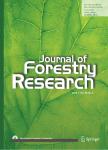Relationship between age, size, fecundity and climatic factors in Panax wangianus an endangered medicinal plant in the sacred grove forest of North-East India
Relationship between age, size, fecundity and climatic factors in Panax wangianus an endangered medicinal plant in the sacred grove forest of North-East India作者机构:Plant Anatomy Lab Department of Botany North-Eastern Hill University Shillong-793022 Meghalaya India
出 版 物:《Journal of Forestry Research》 (林业研究(英文版))
年 卷 期:2011年第22卷第3期
页 面:427-435页
核心收录:
学科分类:1008[医学-中药学(可授医学、理学学位)] 10[医学]
主 题:Panax wangianus medicinal plant North-East India Nongkrem sacred grove climatic factors vegetative and reproductive relationship with age
摘 要:Panax wangianus (Syn. Panax pseudoginseng) S. C. Sun (Araliaceae) is a critically endangered, medicinal plant of North-East India. The objective of this study was to determine how plant size affects flowering phenology and to evaluate the effect of climatic factors on flowering, fruiting and seed production. Data on vegetative and repro- ductive characters were monitored from 2016 individuals of Panax wangianus population in Law Lyngdoh, Smit sacred grove in Nongkrem, Shillong, India. Leaflet area was measured by a planimeter. Size variables of both vegetative and reproductive traits in different age classes were measured. Climatic factors were recorded from 2007 to 2009. Age was recorded by counting the number of bud scale scars on the rhizome. Light intensity and relative humidity were measured using a photometer, LiCor Model LI-189 and thermohygrometer respectively. Different climatic variables are correlated with vegetative and reproductive phenological events. Statistical analysis revealed that a strong positive correlation was observed between the age versus vegetative and reproductive characters, except 1%–2% plants showed neoteny. Morphological variations were observed in natural conditions on the basis of the number of prong and carpellate conditions. Phenological status revealed that most of the individuals of the age class 35–50 years and above 50 years contributed the most to flowering, fruiting and seed production. Age class was significant to predict the size of the plant and its reproductive capacity. Climatic factors such as temperature, precipitation and relative humidity show synergistic effect on both the vegetative and reproductive phases in Panax wangianus in the undisturbed Nongkrem sacred grove. The color of flowers of P. wangianus also varied depending upon the sunlight intensity. Therefore, in the view of conservationand management, the age class of 35–50 years and above 50 years is the most important for population sustainability.



